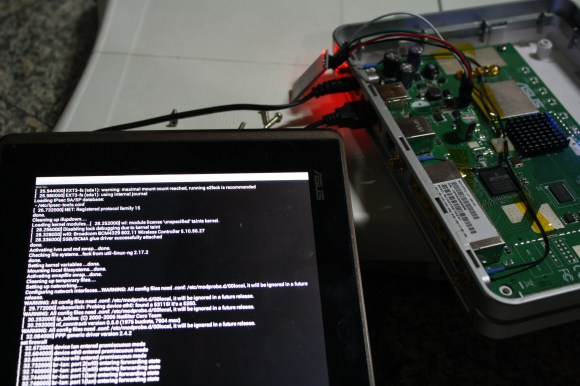
This image shows an Android tablet monitoring the terminal of a router via Bluetooth. It makes it a snap to tweak your router from a multitude of devices as long as you’re within range (usually BT works up to about 30 feet or so). The only part that [Yohanes] needed to pull off the hack was a Bluetooth module which he picked up for a few dollars.
All routers will have serial connections somewhere on the board. His model (Asus RT-N16) even had the GND, RX, TX, and VCC pads labeled. He soldered a SIL pin socket to the port which accepts the pin header from the Bluetooth module. Before plugging that in he had to issue a few commands to the device to get it using the same baud rate and settings as the router’s serial port. With that taken care of he can now wirelessly monitor and control the device via the serial terminal.
The one issue which he did encounter is that the module is slower to boot than the router. This means that at power-up you will not see anything on the terminal until the router has already started to load the Linux kernel. If you don’t plan on doing any bootloader hacks this shouldn’t make any difference.















Thats awesome
I think it would be simple enough to add a reset switch which cuts power to the router and not the bluetooth module. I think I may spend some time hacking my router this weekend :)
Adding a cheap supercapacitor and diode to the bluetooth module power supply should allow it to remain active during a reboot.
I thought something like that. Or just a delay circuit that cuts the power to the router, to give the Bluetooth module time to start up. Maybe the Bluetooth module itself could help, use an 8-pin microcontroller to interrogate it, then when it reports as ready, have the microcontroller switch the power to the router.
It would add a couple of seconds to startup time, but your PC is going to take much longer than that to boot anyway. And as it is, it’s just a bit messy. I wouldn’t like not having terminal access from the beginning. And boot-mods are a popular thing people do with routers like this, AFAIK.
This is a really bad idea, everybody knows bluetooth is broken in all ways. Giving shell access to your router to someone nearby is a Bad Idea (TM).
What I Was Thinking (TM)
[citation needed]
Did you even care to google?
This is just *one* from the several white papers out there.
http://www.eng.tau.ac.il/~yash/shaked-wool-mobisys05/index.html
It takes less than 1 sec to crack a 4 digit pin code in any crappy computer. Is this borken enough for you?
After you can access the router via bluetooth, you still need to have the password to login to DebWrt/OpenWrt/Linux.
Still pretty clever…
If you need a more secure way, you can use an Xbee with data encription. Its far better and it boots really fast. as most routers run on 3.3v logic, the attachment is in the same way: just wiring the pins directly to the sil connector.
Forgive me, but why can’t he just be happy with connecting to the router over the network? Why the unneeded complexities?
It’s very useful when you configure something, and it locks you out of network (e.g: if you mess up your firewall configuration or configured the wrong interface, or some daemon causes the network to be very slow).
Nice! I have few of there BT modules laying around, I’m looking forward to connect them to my NAS!